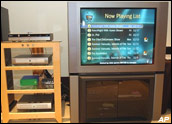
It’s not every day you hear scores of men arguing over whose is the smallest. But in the modern world of mobile computing, it’s a conversation that’s becoming increasingly common.
The nature of today’s business environment means needing to stay connected wherever you are. From ultraslim notebooks to ultramobile PCs and smartphones, the options to have high-tech tools in the pocket of your pants are growing by the month. And one thing’s for sure: In this field, size definitely matters.
The Ultraslim Notebook
The notebook has been steadily shrinking since its introduction. Once known as the “luggable PC,” these things are no longer designed for heavy lifting — in fact, the latest evolution puts the portable computer at about the weight of a quart of milk.
The newest ultraslim model about to hit the market is the Dell Latitude E4200, weighing in at a meager 2.2 lbs. Scheduled to hit store shelves in the coming weeks, the machine boasts a 12.1-inch widescreen display and 1 GB of memory, powered by an Intel Core 2 Duo ultralow voltage processor.
“I had to carry one around — and basically, I didn’t even know it was there,” laughed Dell spokesperson Jeremy Bolen. “I was checking my bag to make sure the system was still there,” he said.
The E4200 — much like its highly hyped but slightly heavier competitor, the MacBook Air — aims to balance size with power. At the same time, though, the size does come with a caveat: It’s not for everyone.
“Generally, they’re tailed to the ‘knowledge worker’ who needs to be very productive when they’re on the road,” Bolen told TechNewsWorld. “A full-functioning notebook is still the way to go for most of our users,” he said.
The reason? No matter what Cosmo says, smaller size does have its limitations. Technology is coming a long way, but there’s still no way companies can pack the same power you’ll find in a desktop PC into a case this small. Still, for simple needs, the ultrathin notebook can carry its weight.
“It all depends on your workload and what you’re doing,” Bolen pointed out.
The Netbook
From the notebook to the netbook, the next class of petite PC takes things even smaller. It’s not quite a laptop — but it’s not pocket-sized, either. It’s “a very low-cost kind of stripped-down version,” Tim Bajarin, president of Creative Strategies, told TechNewsWorld.
These machines typically run on less resource-heavy operating systems, such as Linux, and use low voltage, power-optimized processors. Most have 9- to 10-inch displays. The key distinction, developers have asserted, is that netbooks are designed for consuming — not creating — content. They’re not really meant for any more than simple applications and basic Internet use. Asus’s Eee PC line is largely credited with starting the trend.
“Asus came out with the netbook and threw everybody a little bit of a curve by providing a very low-cost kind of stripped down version of the notebook,” Bajarin noted.
“It started catching on in certain markets … [but] it became pretty clear pretty fast that a netbook was really not enough to meet the needs of a consumer, especially in the U.S. and Europe,” he added.
Still, the model has proven popular for limited use, and for those who don’t require advanced computing power on-the-go.
The Ultramobile PC
Take it down another notch and you come to the ultramobile PC — products such as Samsung’s Q1 or Asus’s R2H. These pocket-sized companions have screens in the 7-inch range and are built with the most mobile tasks in mind.
“We want access to the Internet in one way shape or form,” Pankaj Kedia, director of ecosystem programs for Intel’s Ultra Mobility Group, told TechNewsWorld. “When I’m on the beach or going for coffee or going shopping or what have you, I want to access the Internet in something … that is as personal to me as my wristwatch or my cell phone,” he said.
Intel’s Centrino Atom processors power many of the so-called “mobile internet devices.” They’re geared toward someone who needs to exchange e-mail, send or receive photos, or maybe look up directions on the road.
“If you’re walking around, you’re not going to create a 3-D map of your house on a pocket device. You’re not going to run an … animation when you’re on vacation. You are not going to create … a 50-page presentation on that handheld device,” Kedia explained.
“The experience you want to have is access to the Internet wherever you go,” he added.
The Smartphone
Finally, we reach the smartphone — a device rapidly becoming ubiquitous in the business world. Much like the ultramobile PC, the smartphone is made for the most basic Internet use: checking e-mail, getting directions, or doing simple searches. And with the success of products such as the Apple iPhone, it’s expanding far past the corporate world and into the general population.
“They’ve fundamentally given us a PC in the pocket,” Bajarin said. “What we’re seeing is an upticking demand for smartphones, with Apple leading the way in the context of being the gold standard and forcing the rest of the smartphone vendors to respond in kind.”
While the screen size is the smallest of all the different devices — the iPhone 3G has just a 3.5-inch monitor — the smartphone’s combination of Internet and cellular connectivity makes it a strong contender for a very varied audience.
“You’re getting all the benefits of the basic functionality of a truly mobile environment. Clearly, users are accepting those tradeoffs,” Bajarin commented.
And that, Bajarin suspects, may indicate the wave of the future. He doesn’t see any James Bond-style button computers becoming the norm any time soon.
“I don’t think we’re going to go to tiny,” he noted.
So in the end, shrinking may be the style du jour with today’s technology — but it seems, once again, there just might be such a thing as going too small.





















































